DP and Non-DP. Dynamic positioning of offshore vessels
If you’re considering an offshore fleet, let’s look at the difference between ships with dynamic positioning (DP) and those without. For many offshore operations, it’s necessary to keep a vessel at a fixed position and heading. Traditionally, this has been done using an anchor spread. Nowadays, dynamic positioning (DP) systems are replacing anchors. A seagoing vessel is subjected to forces from wind, waves, and currents as well as from forces generated by the propulsion system.
The vessel’s response to these forces - its changes in position, heading, and speed - is measured by the position-reference systems and the gyrocompass. Readings from the reference systems are corrected for roll and pitch using readings from the vertical reference sensors. Wind speed and direction are measured by the wind sensors. The DP control system calculates the forces that the thrusters must produce to control the vessel’s motion in three degrees of freedom - surge, sway, and yaw - in the horizontal plane. Dynamic positioning systems are typically used by offshore vessels for accurate maneuvering, maintaining a fixed position or track keeping (pipe/cable laying).
DP systems are usually found on offshore drilling vessels (drilling ships and semi-submersibles), offshore support vessels (platform supply vessels (PSVs), well intervention vessels, diving support vessels), pipe-laying and offshore construction vessels, dredging vessels (suction hopper dredgers, trenching vessels), rock-dumping vessels, and shuttle tankers (during offloading of FPSOs)
DP systems are divided into three classes (according to the degree of reliability):
Class 1 (DP 1). The “loss” of a given position by a ship can occur in the event of any single malfunction.
Class 2 (DP 2). “Loss” of position does not occur in the event of a single failure of any subsystem or component (propulsion, sensor, control console, etc.), including cables, pipes, etc.
Class 3 (DP 3). The term “single fault” includes, in addition to the faults specified for Class DP-2, the complete failure of all components within one waterproof or fireproof compartment due to fire or flooding.
A non-DP (Dynamic Positioning) vessel refers to a type of ship or boat that does not have dynamic positioning capabilities.
Non-DP vessels rely on traditional methods of navigation and positioning, such as using anchors, mooring lines, and thrusters for maneuvering and maintaining their position manually. These vessels may be equipped with traditional navigation systems like GPS (Global Positioning System) and other instruments to assist in navigation and maneuvering.
It's important to note that the lack of dynamic positioning capability means that non-DP vessels may not be suitable for operations that require precise and stationary positioning, such as deep sea drilling, subsea construction, or underwater exploration in challenging conditions. In such cases, DP vessels are preferred due to their ability to maintain position accurately and efficiently.
The salary difference between DP (Dynamic Positioning) and non-DP vessels can vary based on several factors, including the type of vessel, job responsibilities, experience level, and location. However, in general, salaries for crew members working on DP vessels tend to be higher compared to those on non-DP vessels.
DP vessels require specialized skills and training, and crew members operating and maintaining the dynamic positioning system are typically paid higher salaries due to the additional responsibilities and technical expertise involved. These positions may include DP operators, DP technicians, DP engineers, and DP officers.
On the other hand, non-DP vessels may have a broader range of crew positions that are not directly related to dynamic positioning operations. These positions can include captains, officers, engineers, deckhands, and other seafarers. The salaries for these roles on non-DP vessels can vary depending on factors such as experience, rank, and the type of vessel.
Additionally, the overall demand and market conditions for DP vessel operations can influence salary levels. In regions or industries where there is a high demand for DP vessels and a shortage of qualified personnel, salaries may be higher to attract and retain skilled crew members.
The integration of DP (Dynamic Positioning) technology into the merchant fleet has been steadily increasing in recent years. While DP systems were traditionally associated with offshore support vessels and specialized industries like oil and gas, they are now being adopted by a wider range of merchant vessels for various purposes.
Here are some key areas where DP integration has been seen in the merchant fleet:
Cruise Ships: Cruise ships are increasingly utilizing DP systems to enhance passenger comfort and safety during operations such as docking and maneuvering in narrow spaces.
Ferries: Some ferry operators have integrated DP technology to optimize docking and ensure precise positioning, improving the efficiency of passenger embarkation and disembarkation.
Specialized Vessels: Other merchant vessels, such as cable-laying ships, pipe-laying vessels, and heavy-lift vessels, are also incorporating DP technology to ensure accurate positioning and stability during critical operations.
The integration of DP systems into the merchant fleet requires specialized training and expertise for crew members responsible for operating and maintaining these systems. There are established guidelines and standards, DP Operator Training Schemes, recommendations and procedures developed by internationally recognized organizations to ensure proper training and certification for DP operators as well as safety of operations.


















